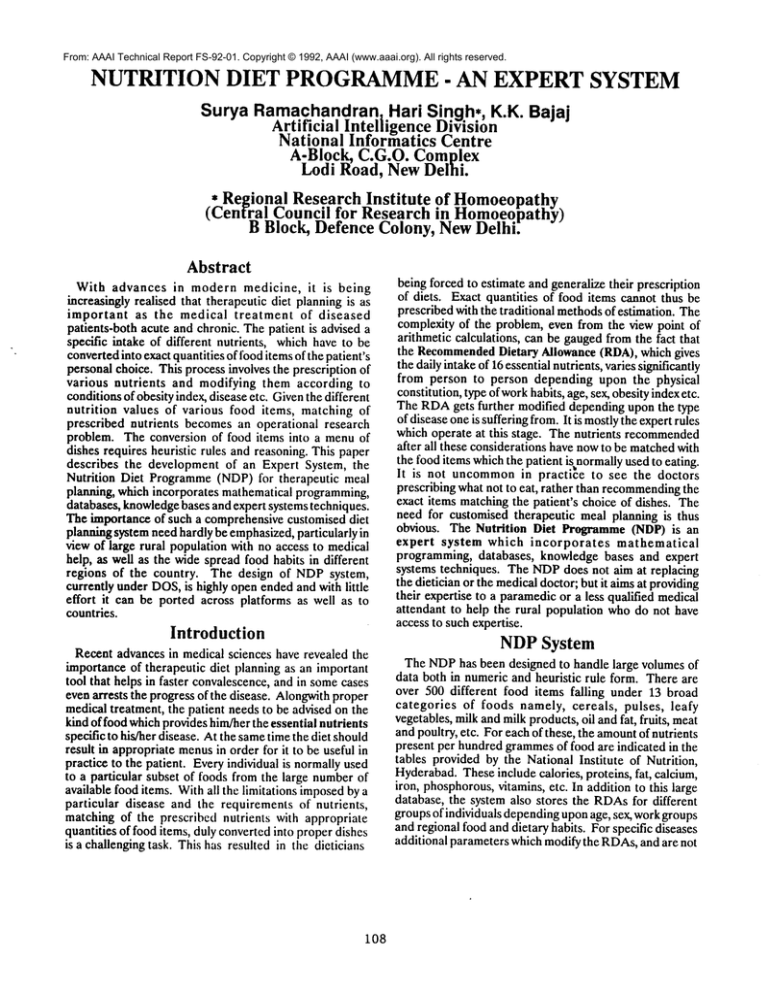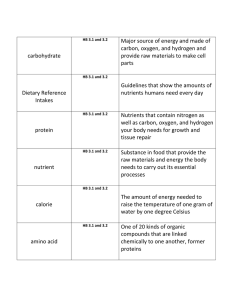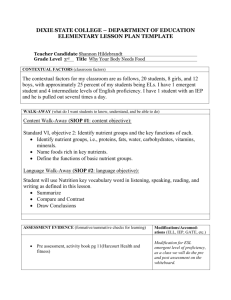
From: AAAI Technical Report FS-92-01. Copyright © 1992, AAAI (www.aaai.org). All rights reserved.
NUTRITION DIET PROGRAMME
- AN EXPERT SYSTEM
Surya Ramachandran,
Hari Singh,, K.K. Bajaj
A_rtificial Intelligence Division
National Informatics Centre
A-Bloc_k, C.G.O. Complex
Lodi Road, NewDelhi.
* Regional Research Institute of Homoeopathy
(Central Council for Research in Homoeopathy)
B Block, Defence Colony, NewDelhi.
Abstract
With advances in modern medicine, it is being
increasingly realised that therapeutic diet planning is as
important as the medical treatment of diseased
patients-both acute and chronic. The patient is advised a
specific intake of different nutrients, which have to be
convertedinto exact quantities of food items of the patient’s
personal choice. This process involves the prescription of
various nutrients and modifying them according to
conditions of obesity index, disease etc. Giventhe different
nutrition values of various food items, matching of
prescribed nutrients becomes an operational research
problem. The conversion of food items into a menu of
dishes requires heuristic rules and reasoning. This paper
describes the development of an Expert System, the
Nutrition Diet Programme (NDP) for therapeutic meal
planning, which incorporates mathematical programming,
databases, knowledgebases and expert systems techniques.
The importance of such a comprehensive customised diet
planning system need hardly be emphasized,particularly in
view of large rural population with no access to medical
help, as well as the wide spread food habits in different
regions of the country. The design of NDPsystem,
currently under DOS,is highly open ended and with little
effort it can be ported across platforms as well as to
countries.
Introduction
Recent advances in medical sciences have revealed the
importance of therapeutic diet planning as an important
tool that helps in faster convalescence, and in somecases
even arrests the progress of the disease. Alongwithproper
medical treatment, the patient needs to be advised on the
kind of food whichprovides him/her the essential nutrients
specific to his/her disease. At the sametime the diet should
result in appropriate menusin order for it to be useful in
practice to the patient. Every individual is normally used
to a particular subset of foods from the large number of
available food items. With all the limitations imposedby a
particular disease and the requirements of nutrients,
matching of the prescribed nutrients with appropriate
quantities of food items, duly converted into proper dishes
is a challenging task. This has resulted in the dieticians
108
being forced to estimate and generalize their prescription
of diets. Exact quantities of food items cannot thus be
prescribed with the traditional methodsof estimation. The
complexity of the problem, even from the view point of
arithmetic calculations, can be gaugedfrom the fact that
the RecommendedDietary Allowance (RDA), which gives
the daily intake of 16 essential nutrients, varies significantly
from person to person depending upon the physical
constitution, type of workhabits, age, sex, obesity index etc.
The RDAgets further modified depending upon the type
of disease one is suffering from. It is mostlythe expert rules
which operate at this stage. The nutrients recommended
after all these considerations have nowto be matchedwith
the food items whichthe patient is.If normally used to eating.
It is not uncommonin practice to see the doctors
prescribing what not to eat, rather than recommendingthe
exact items matching the patient’s choice of dishes. The
need for customised therapeutic meal planning is thus
obvious. The Nutrition Diet Programme(NDP) is an
expert system which incorporates
mathematical
programming, databases, knowledge bases and expert
systems techniques. The NDPdoes not aim at replacing
the dietician or the medical doctor; but it aimsat providing
their expertise to a paramedic or a less qualified medical
attendant to help the rural population who do not have
access to such expertise.
NDP System
The NDPhas been designed to handle large volumes of
data both in numeric and heuristic rule form. There are
over 500 different food items falling under 13 broad
categories of foods namely, cereals, pulses, leafy
vegetables, milk and milk products, oil and fat, fruits, meat
and poultry, etc. For each of these, the amountof nutrients
present per hundred grammesof food are indicated in the
tables provided by the National Institute of Nutrition,
Hyderabad.These include calories, proteins, fat, calcium,
iron, phosphorous,vitamins, etc. In addition to this large
database, the system also stores the RDAsfor different
groups of individuals depending upon age, sex, work groups
and regional food and dietary habits. For specific diseases
additional parameters which modify the RDAs,and are not
From: AAAI Technical Report FS-92-01. Copyright © 1992, AAAI (www.aaai.org). All rights reserved.
necessarily mathematical rules, have to be stored. These
rules are mostly in the form of heuristic rules suggested by
the expert dieticians.
The system has been developed on DOSplatform, with
Prolog from Logic Programmi,lg Associates as the
developmentvehicle. Facts, such as nutrients in food items
and rules, in both numericas well as heuristic form, can be
conveniently expressed in this language. The mathematical
programming techniques, in particular,
the ORLinear
Programmingpackage (LP88) can be easily interfaced with
Prolog. The NDP,in its present form, already includes the
database on about 575 food items, 200 commondiseases
prevalent in India, arithmetic calculations, LP88interface
and the necessary heuristic rules.
The NDPaims at delivering a complete customised diet
plan for the patient. For this purpose, details about the
patient have to be entered into the system. This process has
been divided into two parts, one of which is the fixed
information about the patient such as personal details like
age, height, sex, type of worketc. Thesecan be entered into
the system through an appropriate form displayed at the
time the consultation session begins. All the dynamic
parameters about disease etc., are entered through
appropriate queries generated by the system. It is this user
interface which increases the level of cooperativeness
between the patient and the NDPuser. Ouery the User
(OtU) techniques of Prolog have been used for the user
interface.
Oncethe primary inputs on the patient have been entered
into the system through the form, NDPretrieves the
appropriate RDAwhich gives a daily intake of 16 essential
nutrients prescribed in the table. The system then queries
the user as to the disease of the patient, by grouping the
diseases into disorder category and the list of diseases into
the relevant category. The inputs provided by the user
modify the RDAfor the specific type of disease selected.
The obesity index of the individual plays an important role
since it influences the total calorie and fat intake. It is at
this stage that the patient is asked to provide his preferred
food items and eating habits. The interplay of these and the
heuristic rules shapes the construction of a batch file which
forms the input to the LP88package. The system takes the
RDAsand the food items as the input and comes out with
appropriate
quantities
of food items taking into
consideration the constraints. Simple methods of linear
programming and more sophisticated goal programming
have been used to modify the quantities of food items.
Further, at this stage either the solution is found to be
feasible or infeasible. In the case of a non-optimalsolution,
the heuristic rules regarding the importance of main
nutrients like calories, fats and proteins enable the system
to modify the non-optimal solution in some ways so as to
reach a partially optimal solution. The expert rules,
however, ensure that the other nutrients are not grossly
violated.
The next task of the systemis to try and fit the quantities
of different food items into appropriate dishes such that
they conformto patient’s eating habits. At this stage some
109
other heuristic rules in the form of food exchange tables
also comeinto play. The final output of NDPconsists of
three different parts: (1) A daily menufor seven days with
food table so that the user can readily interchange the
contents of his/her dishes. (2) Alist of food restrictions
to the foods whichare strictly forbidden. (3) In case of any
excess of calories coming out of the solution,
a
recommended
list of exercises.
Conclusion
It may be pointed out that in India, which is like a
subcontinent of 25 states, the eating habits and dishes
prepared are very large in number and result in a
complexity which might equal that posed by the whole of
Europe. In the first instance we are endeavouring to cater
to the needsof patients in 58 districts spread over 10 states.
We propose to eventually
make NDP available
on
computer systems already installed by the National
Informatics Centre (NIC) in all the districts of the country
for consultation by doctors and paramedics. A number of
modernhospitals in cities like Bombayand Delhi have also
expressed a desire to install and experiment with the NDP,
besides the National Institute of Nutrition, Hyderabad.
There are many avenues open to improve the system or
to modify for other environments. Newideas evolving from
the system, such as the user feedback facility, can be used
to enhance the knowledge base of the NDPbased on the
queries of the user. The package can be easily ported on
to other computer platforms using different versions of
Proiog. It can also be easily tailored to the requirementsof
various countries by suitably enhancing the database on
their respective dishes.
References
Bajaj K.K., Dubash R.K., Kamble A.S., Kowalski R.,
Murthy B.K., Rajagopalan
D. (1992),
Indian
Import-Export Policyand Procedures as a Logic Program,
in Expert Systems in Lawedited by A.Martins, Elsevier
Science Publishers B.V.
Kowalski R. (1979), Logic for Problem Solving, North
Holland.
National Institute of Nutrition, Hyderabad,Publications:
1. Nutritive Value of Indian Foods, 1991.
2. SomeTherapeutic Diets, 1990.
Quintus, LPAProlog, Reference Manual, August, 1990.
Sergot M.J. (1982), A Query the User facility for Logic
Programming.
Research Report,
Department of
Computing, Imperial College of Science, Technology &
Medicine, London.
Sergot M.J., Sadri F., Kowalski R.A., Kriwaczek F.,
Hammond
P., Cory H.T. (1986), The British Nationality
Act as a Logic Program, Communicationsof the A.C.M.,
Vol. 29, No.5, pp. 370-386.





